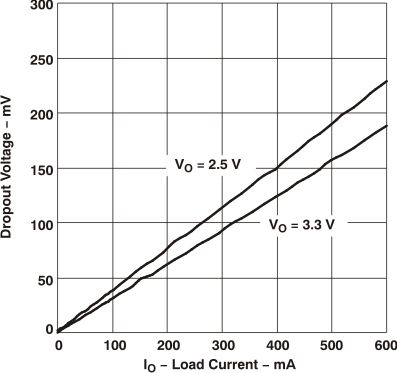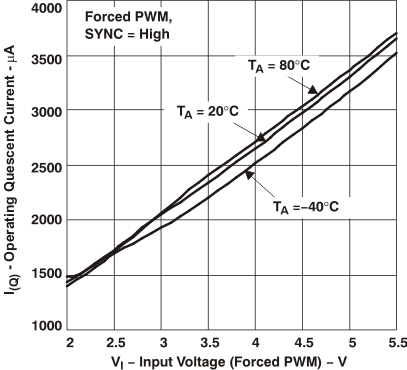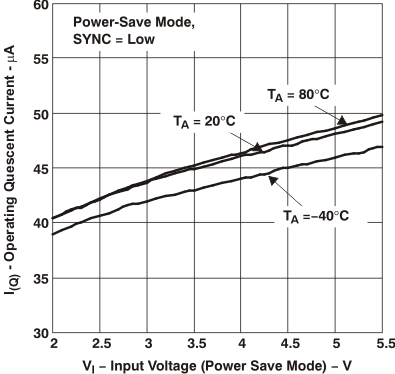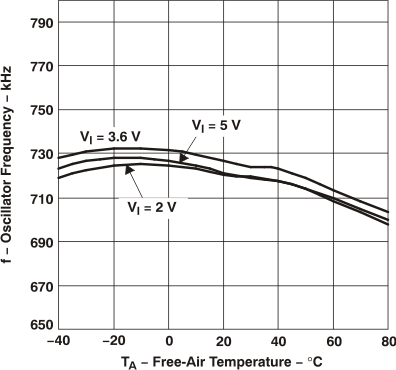SLVS294F September 2000 – August 2015 TPS62000 , TPS62002 , TPS62003 , TPS62004 , TPS62005 , TPS62006 , TPS62007 , TPS62008
PRODUCTION DATA.
- 1 Features
- 2 Applications
- 3 Description
- 4 Revision History
- 5 Device Comparison Table
- 6 Pin Configuration and Functions
- 7 Specifications
- 8 Detailed Description
-
9 Application and Implementation
- 9.1 Application Information
- 9.2 Typical Application
- 9.3
System Examples
- 9.3.1 Standard 5-V to 3.3-V/600-mA Conversion; High Efficiency
- 9.3.2 Single Li-ion to 2.5-V/600-mA Using Ceramic Capacitors Only
- 9.3.3 Single Li-ion to 1.8 V/300 mA; Smallest Solution Size
- 9.3.4 Dual Cell NiMH or NiCd to 1.2 V/200 mA; Smallest Solution Size
- 9.3.5 Dynamic Output Voltage Programming As Used in Low Power DSP Applications
- 10Power Supply Recommendations
- 11Layout
- 12Device and Documentation Support
- 13Mechanical, Packaging, and Orderable Information
Package Options
Refer to the PDF data sheet for device specific package drawings
Mechanical Data (Package|Pins)
- DGS|10
Thermal pad, mechanical data (Package|Pins)
Orderable Information
7 Specifications
7.1 Absolute Maximum Ratings
Over operating free-air temperature range (unless otherwise noted)(1)| MIN | MAX | UNIT | ||
|---|---|---|---|---|
| Supply voltages on pin VIN and FC(2) | –0.3 | 6 | V | |
| Voltages on pins EN, ILIM, SYNC, PG, FB, L(2) | –0.3 | VIN + 0.3 | V | |
| Peak switch current | 1.6 | A | ||
| TJ | Operating junction temperature | –40 | 150 | °C |
| Lead temperature (soldering, 10 sec) | 260 | °C | ||
| Tstg | Storage temperature | –65 | 150 | °C |
(1) Stresses beyond those listed under Absolute Maximum Ratings may cause permanent damage to the device. These are stress ratings only, and functional operation of the device at these or any other conditions beyond those indicated under Recommended Operating Conditions is not implied. Exposure to absolute-maximum-rated conditions for extended periods may affect device reliability.
(2) All voltage values are with respect to network ground terminal.
7.2 ESD Ratings
| VALUE | UNIT | |||
|---|---|---|---|---|
| V(ESD) | Electrostatic discharge | Human body model (HBM), per ANSI/ESDA/JEDEC JS-001(1) | ±2000 | V |
| Charged device model (CDM), per JEDEC specification JESD22-C101(2) | ±1000 | |||
(1) JEDEC document JEP155 states that 500-V HBM allows safe manufacturing with a standard ESD control process.
(2) JEDEC document JEP157 states that 250-V CDM allows safe manufacturing with a standard ESD control process.
7.3 Recommended Operating Conditions
Over operating free-air temperature range (unless otherwise noted)| MIN | NOM | MAX | UNIT | ||
|---|---|---|---|---|---|
| VIN | Supply voltage | 2 | 5.5 | V | |
| VOUT | Output voltage range for adjustable output voltage version | 0.8 | VIN | V | |
| IOUT | Output current for 3-cell operation (VIN ≥ 2.5 V; L = 10 μH, f = 750 kHz) | 600 | mA | ||
| IOUT | Output current for 2-cell operation (VIN ≥ 2 V; L = 10 μH, f = 750 kHz) | 200 | mA | ||
| L | Inductor(1) (see Note 2) | 10 | μH | ||
| CIN | Input capacitor(1) | 10 | μF | ||
| COUT | Output capacitor(1) (VOUT ≥ 1.8 V) | 10 | μF | ||
| COUT | Output capacitor(1) VOUT < 1.8 V) | 47 | μF | ||
| TA | Operating ambient temperature | –40 | 85 | °C | |
| TJ | Operating junction temperature | –40 | 125 | °C | |
(1) Refer to Application Information section for further information.
7.4 Thermal Information
| THERMAL METRIC(1) | TPS6200x | UNIT | |
|---|---|---|---|
| DGS [VSSOP] | |||
| 10 PINS | |||
| RθJA | Junction-to-ambient thermal resistance | 160 | °C/W |
| RθJC(top) | Junction-to-case (top) thermal resistance | 51 | °C/W |
| RθJB | Junction-to-board thermal resistance | 73 | °C/W |
| ψJT | Junction-to-top characterization parameter | 5.0 | °C/W |
| ψJB | Junction-to-board characterization parameter | 72 | °C/W |
| RθJC(bot) | Junction-to-case (bottom) thermal resistance | N/A | °C/W |
(1) For more information about traditional and new thermal metrics, see the Semiconductor and IC Package Thermal Metrics application report, SPRA953.
7.5 Electrical Characteristics
Over recommended operating free-air temperature range, VIN = 3.6 V, VOUT = 2.5 V, IOUT = 300 mA, EN = VIN, ILIM = VIN, TA = –40°C to 85°C (unless otherwise noted)| PARAMETER | TEST CONDITIONS | MIN | TYP | MAX | UNIT | ||
|---|---|---|---|---|---|---|---|
| SUPPLY CURRENT | |||||||
| VIN | Input voltage range | IOUT = 0 mA to 600 mA | 2.5 | 5.5 | V | ||
| IOUT = 0 mA to 200 mA | 2 | 5.5 | |||||
| I(Q) | Operating quiescent current | IOUT = 0 mA, SYNC = GND (PFM-mode enabled) | 50 | 75 | μA | ||
| I(SD) | Shutdown current | EN = GND | 0.1 | 1 | μA | ||
| ENABLE | |||||||
| VIH | EN high-level input voltage | 1.3 | V | ||||
| VIL | EN low-level input voltage | 0.4 | V | ||||
| Ilkg | EN input leakage current | EN = GND or VIN | 0.01 | 0.1 | μA | ||
| V(UVLO) | Undervoltage lockout threshold | 1.2 | 1.6 | 1.95 | V | ||
| POWER SWITCH AND CURRENT LIMIT | |||||||
| RDS(on) | P-channel MOSFET on-resistance | VIN = VGS = 3.6 V, I = 200 mA | 200 | 280 | 410 | mΩ | |
| VIN = VGS = 2 V, I = 200 mA | 480 | ||||||
| P-channel leakage current | VDS = 5.5 V | 1 | μA | ||||
| N-channel MOSFET on-resistance | VIN = VGS = 3.6 V, IOUT = 200 mA | 200 | 280 | 410 | mΩ | ||
| VIN = VGS = 2 V, IOUT = 200 mA | 500 | ||||||
| N-channel leakage current | VDS = 5.5 V | 1 | μA | ||||
| I(LIM) | P-channel current limit | 2.5 V ≤ VIN ≤ 5.5 V, ILIM = VIN | 800 | 1200 | 1600 | mA | |
| 2 V ≤ VIN ≤ 5.5 V, ILIM = GND | 390 | 600 | 900 | ||||
| VIH | ILIM high-level input voltage | 1.3 | V | ||||
| VIL | ILIM low-level input voltage | 0.4 | V | ||||
| Ilkg | ILIM input leakage current | ILIM = GND or VIN | 0.01 | 0.1 | μA | ||
| POWER GOOD OUTPUT (see (1)) | |||||||
| V(PG) | Power good threshold | Feedback voltage falling | 88% VOUT | 92% VOUT | 94% VOUT | V | |
| Power good hysteresis | 2.5% VOUT | V | |||||
| VOL | PG output low voltage | V(FB) = 0.8 × VOUT nominal, I(sink) = 10 μA | 0.3 | V | |||
| Ilkg | PG output leakage current | V(FB) = VOUT nominal | 0.01 | 1 | μA | ||
| Minimum supply voltage for valid power good signal | 1.2 | V | |||||
| OSCILLATOR | |||||||
| fs | Oscillator frequency | 500 | 750 | 1000 | kHz | ||
| f(SYNC) | Synchronization range | CMOS-logic clock signal on SYNC pin | 500 | 1000 | kHz | ||
| VIH | SYNC high level input voltage | 1.3 | V | ||||
| VIL | SYNC low level input voltage | 0.4 | V | ||||
| Ilkg | SYNC input leakage current | SYNC = GND or VIN | 0.01 | 0.1 | μA | ||
| Duty cycle of external clock signal | 20% | 60% | |||||
| VO | Adjustable output voltage range | TPS62000 | 0.8 | 5.5 | V | ||
| Vref | Reference voltage | TPS6200x | 0.45 | V | |||
| VOUT | Fixed output voltage | TPS62000 adjustable | VIN = 2.5 V to 5.5 V; 0 mA ≤ IOUT ≤ 600 mA | –3% | 4% | V | |
| 10 mA < IOUT ≤ 600 mA | –3% | 3% | |||||
| TPS62001 0.9 V | VIN = 2.5 V to 5.5 V; 0 mA ≤ IOUT ≤ 600 mA | –3% | 4% | ||||
| 10 mA < IOUT ≤ 600 mA | –3% | 3% | |||||
| TPS62002 1 V |
VIN = 2.5 V to 5.5 V; 0 mA ≤ IOUT ≤ 600 mA | –3% | 4% | ||||
| 10 mA < IOUT ≤ 600 mA | –3% | 3% | |||||
| TPS62003 1.2 V |
VIN = 2.5 V to 5.5 V; 0 mA ≤ IOUT ≤ 600 mA | –3% | 4% | ||||
| 10 mA < IOUT ≤ 600 mA | –3% | 3% | |||||
| TPS62004 1.5 V |
VIN = 2.5 V to 5.5 V; 0 mA ≤ IOUT ≤ 600 mA | –3% | 4% | ||||
| 10 mA < IOUT ≤ 600 mA | –3% | 3% | |||||
| TPS62005 1.8 V |
VIN = 2.5 V to 5.5 V; 0 mA ≤ IOUT ≤ 600 mA | –3% | 4% | ||||
| 10 mA < IOUT ≤ 600 mA | –3% | 3% | |||||
| TPS62008 1.9 V |
VIN = 2.5 V to 5.5 V; 0 mA ≤ IOUT ≤ 600 mA | –3% | 4% | ||||
| 10 mA < IOUT ≤ 600 mA | –3% | 3% | |||||
| TPS62006 2.5 V |
VIN = 2.7 V to 5.5 V; 0 mA ≤ IOUT ≤ 600 mA | –3% | 4% | ||||
| 10 mA < IOUT ≤ 600 mA | –3% | 3% | |||||
| TPS62007 3.3 V |
VIN = 3.6 V to 5.5 V; 0 mA ≤ IOUT ≤ 600 mA | –3% | 4% | ||||
| 10 mA < IOUT ≤ 600 mA | –3% | 3% | |||||
| Line regulation | VIN = VOUT + 0.5 V (min. 2 V) to 5.5 V, IOUT = 10 mA | 0.05 | %/V | ||||
| Load regulation | VIN = 5.5 V; IOUT = 10 mA to 600 mA | 0.6% | |||||
| η | Efficiency | VIN = 5 V; VOUT = 3.3 V; IOUT = 300 mA | 95% | ||||
| VIN = 3.6 V; VOUT = 2.5 V; IOUT = 200 mA | |||||||
| Start-up time | IOUT = 0 mA, time from active EN to VOUT | 0.4 | 2 | ms | |||
(1) Power good is not valid for the first 100 μs after EN goes high. Refer to the application section for more information.
7.6 Typical Characteristics
 Figure 1. Dropout Voltage vs Load Current
Figure 1. Dropout Voltage vs Load Current
 Figure 3. Operating Quiescent Current vs Input Voltage (Forced PWM)
Figure 3. Operating Quiescent Current vs Input Voltage (Forced PWM)
 Figure 2. Operating Quiescent Current vs Input Voltage (Power Save Mode)
Figure 2. Operating Quiescent Current vs Input Voltage (Power Save Mode)
 Figure 4. Oscillator Frequency vs Free-Air Temperature
Figure 4. Oscillator Frequency vs Free-Air Temperature